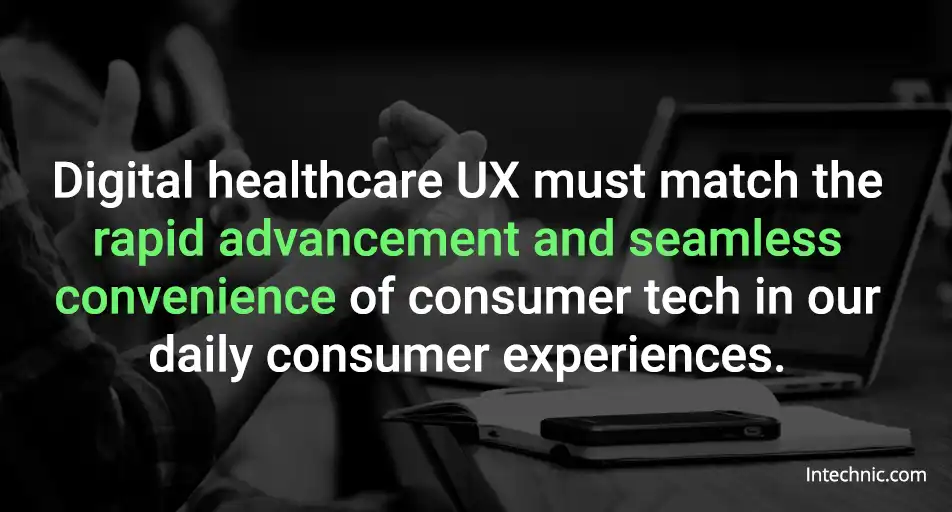IIn recent years, the digital healthcare landscape has undergone a transformative journey, significantly elevating the role of user experience (UX) in this vital sector. From better access to electronic health records to incorporating virtual reality and augmented reality into healthcare to wearable devices and voice user interfaces, the emphasis on digital experiences in healthcare has become more crucial than ever, mirroring the industry's ongoing commitment to innovation, accessibility, efficiency, and patient-centered care.
This shift reflects how the digital aspects of healthcare UX design have evolved, moving from a secondary consideration to a cornerstone of healthcare delivery. This evolution, marked by new technologies and a deeper understanding of patient needs, has reshaped the way patients interact with services, making digital UX an indispensable aspect of modern healthcare. So what are the latest trends and what UX digital trends and innovations do we foresee in the health tech sector in the near future?
Adapting to consumer-like digital experience expectations in healthcare UX
In recent years, the expectations of both patients and healthcare providers (HCPs) in the digital domain have increasingly mirrored those in the consumer market. As digital experiences become integral to everyday life and continue to advance rapidly, influenced heavily by consumer brands' seamless technology interactions, there's a growing demand for similar convenience and efficiency in healthcare digital platforms.
The past decade has seen a significant shift in healthcare experiences to the digital space. Patients have begun to be viewed as "consumers," a term that underscores their autonomy and choice in a competitive environment. Despite this shift, there's a noticeable disparity in the level of user experience (UX) offered in digital healthcare products compared to what patients and their caregivers, along with HCPs, are accustomed to in other aspects of their lives.
This mismatch between the expected and actual healthcare experiences can result in frustration, diminished trust, and adversely affect patient care. Recognizing this, healthcare companies are increasingly focusing on enhancing their digital platforms to improve engagement and satisfaction among patients and HCPs, bridging the gap between expectation and reality.

The growing role of user research in healthcare UX
User research is an indispensable element in the UX design process, especially critical for healthcare and pharmaceutical organizations. It involves delving deeply into the needs and behaviors of target users, such as patients, caregivers, and healthcare professionals. These groups have distinct requirements and expectations when it comes to healthcare technology products, making it challenging to create a positive user experience without comprehensive insights into their unique behaviors and motivations.
In healthcare, the role of usability testing and user research extends beyond basic functionality; it is essential for developing digital products and services that are effective and safe. A thorough understanding of user needs allows designers to craft solutions that not only reduce errors but also enhance user engagement and adherence to treatments. This leads to improved health outcomes and a significant, positive impact on patients' lives.
Moreover, user-centricity in digital healthcare solutions demands quantifiable measures of effectiveness. Whether designing websites, healthcare apps, or digital portals, it's crucial to assess how well these platforms meet user needs. Real-user testing, encompassing both patients and HCPs, is key to removing biases that often emerge from internal stakeholder opinions or 'design by committee' approaches. Embracing a data-driven strategy enables digital teams to move beyond decisions influenced by the most dominant voices. This approach prioritizes research, data, and actual user feedback, ensuring digital experiences are not only designed but also refined based on the genuine needs and satisfaction of their intended users.

Embracing an omnichannel approach
The concept of omnichannel in healthcare is rapidly gaining traction, reflecting a growing trend towards more integrated and seamless interactions with both patients and doctors. In today's digital age, where the lines between different communication platforms are increasingly blurred, an omnichannel approach ensures a cohesive user experience across various digital and physical touchpoints. This strategy is crucial in healthcare, as it facilitates a more personalized and efficient journey for patients, allowing them to transition smoothly between online consultations, in-person visits, and other forms of communication with health services.
Moreover, the adoption of omnichannel strategies in healthcare is not just a response to current digital trends but a proactive step towards future-proofing healthcare services. As technology continues to advance, the ability to seamlessly integrate new digital tools and platforms into the existing healthcare ecosystem will be paramount. This will not only enhance patient engagement and satisfaction but also empower healthcare professionals with more robust and flexible tools to provide care. Ultimately, the move towards omnichannel healthcare is about creating a more connected, efficient, and patient-centered healthcare system, meeting the needs of today's digital-savvy patients and providers.

The rise of personalization in healthcare UX design
Personalization in healthcare is becoming increasingly vital, with a growing emphasis on tailoring experiences to meet the specific needs of all users. In patient experience, the sense of empowerment and engagement is significantly enhanced when they can choose services and features that align with their unique circumstances, such as medical conditions, medications, and insurance details. The ability to personalize their experience and retain these preferences across various interactions signifies that the healthcare system is attentive to their individual needs. This level of customization not only fosters a deeper sense of connection with the healthcare organization but also motivates patients to stay engaged and proactive in managing their health.
For providers, personalization is equally important but serves a different purpose. Clinicians are often pressed for time, juggling numerous responsibilities. A personalized experience in their digital tools can streamline their workflows, making tasks quicker and more efficient. By having access to relevant patient information and preferences at their fingertips, HCPs can provide more focused and effective care.
Incorporating artificial intelligence (AI) is a key factor in enhancing personalization in healthcare. AI can analyze large datasets to identify patterns and preferences, enabling healthcare platforms to offer more personalized recommendations and experiences. For patients, this could mean receiving suggestions for health management plans or medication adjustments based on their health history. For HCPs, AI-driven personalization might involve presenting relevant information in a prioritized manner, aiding in quick decision-making. AI's ability to process and learn from vast amounts of data makes it an invaluable tool in delivering highly personalized healthcare experiences, improving both patient satisfaction and clinical efficiency in healthcare and pharma industries.

Designing for accessibility and inclusivity in digital health
The integration of digital health tools is essential for enhancing healthcare access, promoting self-care, and improving communication between patients and providers. However, the effectiveness of these tools hinges on their ability to address cultural, linguistic, and economic differences among various populations. Failing to consider these disparities in healthcare UX can lead to lower adoption rates among disadvantaged groups, exacerbating existing health inequalities.
Addressing health equity and inclusion is not just a matter of fairness, social justice, and human rights in healthcare; it is also economically prudent. Achieving equal access to healthcare services can greatly reduce costs and enhance the efficiency of the healthcare industry. Research indicates that health disparities contribute to approximately $93 billion in excess healthcare costs and $42 billion in lost productivity annually, not to mention the economic impact of premature deaths.1
Consequently, healthcare organizations are recognizing the need to design digital health tools with a user-centered approach that caters to the diverse needs and preferences of all individuals, especially those from vulnerable communities. User experience can help to promote health equity and inclusion.
The approach includes integrating user-centered design principles, creating multilingual interfaces to overcome language barriers, offering targeted health information for diverse groups, ensuring optimal usability for people with disabilities, and involving marginalized communities in the design process.

Transforming digital healthcare with AI
The role of AI goes far beyond the digital trends in shaping the digital healthcare UX is growing rapidly, revolutionizing how both HCPs and patients interact with healthcare services. For providers, AI-driven tools are streamlining workflows and enhancing decision-making processes. These tools can analyze vast amounts of data, from patient records to the latest medical research, providing HCPs with actionable insights. This not only improves the accuracy of diagnoses and treatment plans but also saves valuable time, allowing healthcare professionals to focus more on patient care rather than administrative tasks.
For patients, AI is transforming the healthcare UX design by offering more personalized and responsive interactions. AI-powered apps and platforms can track health metrics, suggest lifestyle changes, and even predict potential health issues before they become serious. This level of personalized care, tailored to the individual's specific health conditions and needs, empowers them to take an active role in their health management. Additionally, AI-enabled chatbots and virtual health assistants are providing patients with instant access to medical advice and support, making healthcare more accessible and convenient.
The integration of AI into digital healthcare is not just about technological advancement; it benefits UX designers as well, giving them additional tools for creating more efficient, effective, and patient-centered healthcare systems. As AI technology continues to evolve, its role in digital healthcare is set to become even more pivotal, shaping the future of healthcare delivery for both HCPs and patients.

As we explore the digital trends of healthcare UX, it's clear that the digital healthcare experience is poised for profound transformations. Advancements in healthcare technology, coupled with a deepening understanding of user needs, are reshaping healthcare interactions, making user experience a pivotal aspect of care delivery. This journey into the future of digital healthcare UX promises not only enhanced efficiency and accessibility but also a more personalized and inclusive approach to patient and provider experiences, ultimately revolutionizing the way we view and engage with healthcare services.
Reference:
1. Altarum. The Business Case For Racial Equity: A Strategy For Growth. 2018.


